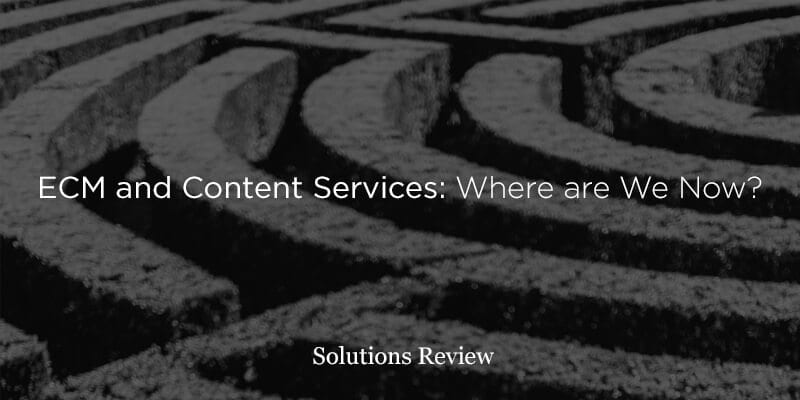ECM and Content Services: Where are We Now?

 Since Gartner Inc. declared that Enterprise Content Management (ECM) was dead in early 2017, the popularity of content services has increased. Though ECM is supposedly dead, some organizations still make use of ECM solutions, while others shifted to content services. Not only this, but many providers offer both content management and content services solutions. The two terms are used interchangeably at times because, even two years after Gartner’s declaration, the difference between them is still a bit murky. However, there is, in fact, a difference between ECM and content services. But more importantly, where do content management and content services stand now? To answer that, we have to go back to the beginning, before content services.
Since Gartner Inc. declared that Enterprise Content Management (ECM) was dead in early 2017, the popularity of content services has increased. Though ECM is supposedly dead, some organizations still make use of ECM solutions, while others shifted to content services. Not only this, but many providers offer both content management and content services solutions. The two terms are used interchangeably at times because, even two years after Gartner’s declaration, the difference between them is still a bit murky. However, there is, in fact, a difference between ECM and content services. But more importantly, where do content management and content services stand now? To answer that, we have to go back to the beginning, before content services.
What is ECM?
ECM began as a means to merge the capabilities of different types of content repositories together. These included enterprise document management (EDM), web content management (WCM), and digital asset management (DAM). ECM showed that the content supported by these platforms shared common business requirements, and provided a single platform for all the content they included.
However, documents, web pages, and rich media began to be used differently over time. For this reason, it became more difficult to manage content from a single platform, as the differences between their use cases were too drastic. At this point, the meaning of content management started to shift. While ECM still offered a single platform for all the documents in a company, these types of solutions became more about standard principles. The focus shifted to creating an enterprise approach to managing content, regardless of where and how it was stored.
The Shift from ECM to Content Services Continues
Things shifted further when Gartner stated that ECM was “dead (kaput, finite, an ex-market name), at least in how Gartner defines the market.” Some were resistant to Gartner’s renaming of enterprise content management to content services and continued referring to the industry as ECM. However, Gartner’s rationale was that content management had become a supporting functionality for other applications, rather than a form of management that could stand on its own. The research analyst house reasoned that the strategy of enterprise content management “was to provide a centralized enterprise (the E in ECM) wide platform that could meet one or all of the following primary goals associated with the utilization of ‘content’:
- Regulatory compliance and risk management
- Retention and dissemination of business knowledge
- Cost and process efficiencies
- Innovation and new ways of working”
However, Gartner found that it was almost impossible to achieve all four of these goals through the use of a single platform, and therefore declared the death of content management.
What is Content Services?
After these events, content services enters the enterprise technology space. The content services approach is focused more on strategy than the actual technology behind it. This method combines the up and coming technology of the future with the reality of what is currently happening in the digital enterprise. For example, many organizations need multiple repositories rather than just one, making content services a better option for some.
Gartner defines content services as “a set of services and microservices, embodied either as an integrated product suite or as separate applications that share common APIs and repositories, to exploit diverse content types and to serve multiple constituencies and numerous use cases across an organization.” In other words, content services are meant to solve multiple business process issues with multiple integrated solutions throughout an organization.
How do They Differ?
The difference between enterprise content management and content services boils down to a centralized approach versus a more universal one. The goal of enterprise content management is to accomplish a range of operational goals through the use of a single centralized platform. On the other side, content services are meant to improve efficiency by relying on multiple strategies and tools. Content services have less of a focus on content storage for the enterprise, and instead, focus on how the content is used by individuals and teams and then uses that information to gain insight into the overall business operations. Content services solutions focus on essential questions, such as:
- Who is storing and processing the content?
- How can a unified content strategy help users work more efficiently?
- What additional technologies can be integrated with the centralized storage platform in order to achieve business goals?
Where does ECM Stand Now?
Gartner’s choice to redefine what is relevant speaks to a shift in the way businesses use content, internally and externally. Enterprise content management solutions act as a means of converting paper documents into electronic information and sharing that information to employees. But today, digital organizations are in need of more holistic services. There is a need for platforms that can compile content across multiple repositories in order to connect dissimilar applications.
While ECM is still a valid way to handle content that continues to be offered by a range of IT management companies, it is not as easily adaptable to the needs of today’s businesses and can be limited by its centralized platform. Though both content management and content services solutions are in use today, the use of multiple tools in content services allows for a more strategic approach to solving business process problems. In the end, the most effective solution hinges on how dependent an organization is on varying kinds of digital content.
Looking for more information on enterprise content management and content services solutions? Consider downloading our Content Management Buyer’s Guide! This free resource gives you the ability to compare the top 20 products available on the market with full page vendor profiles. The guide also offers five questions to ask yourself and five questions to ask your software provider before purchasing. It’s the best resource for anyone looking to find the right content management or content services solution for their organization.
Widget not in any sidebars



















